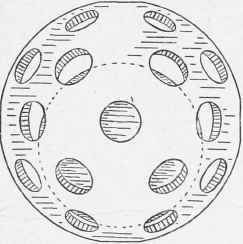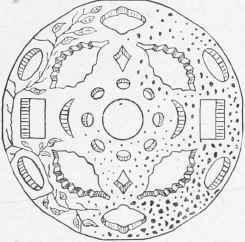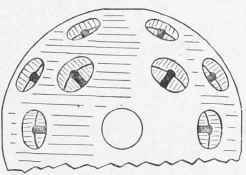How To Cut A Wooden Ball Inside Another
Description
This section is from the book "Cassell's Cyclopaedia Of Mechanics", by Paul N. Hasluck. Also available from Amazon: Cassell's Cyclopaedia Of Mechanics.
How To Cut A Wooden Ball Inside Another
For cutting balls one inside another, sycamore, about 3| in. in diameter, is most suitable. Determine the top and bottom of the ball, and bore there holes 1/2m. deep with a 5/8in. Jennings' auger-bit. Then bore eight similar equidistant holes around the middle, eight on each side of the middle series, and four around the top and bottom holes, always directing the point of the bit towards the centre. Fig. 1 shows how to distribute the holes. With a sharp gimlet, bore from hole to hole in all directions about 1/4 in. below the surface; then cut all ways with a fretsaw or keyhole blade (see Fig. 3) until the interior is disconnected, taking care not to roughen the edges of the holes too much. Now cut downwards (see the thick lines, Fig. i) from the gimlet holes to the depth of the 5/8-in. holes with a wood-carving knife having a blade similar to Fig. 5, and remove the splinters, leaving a solid ball enclosed by a thin covering. Then trim the inner ball and all the holes in the outer shell with a riffler resembling Fig. 6. To obtain a hollow perforated ball somewhat larger than the solid one, bore holes in the same positions but right through to the centre, so that opposite holes meet; thus the interior of the ball is gradually hollowed. Use the gimlet and saw as before; then carefully work over the surface and interior of the inner perforated ball with the riffler and the knife passed through the holes. When the two balls are quite independent, remove the saw marks from the inside of the outer ball. The number, size, and shape of the holes can be varied in different specimens. Fig. 2 illustrates one style of finish, but to avoid complications the inner ball is not shown. Scatter numerous small holes (as around the centre) over the ball, giving it the appearance of network. Intermix stars, crescents, etc., and square off some of the holes, or imitate roughly the outline of a leaf. Instead of cutting holes, indent continuous branches with small leaves attached, traversing the surface at every available blank. Application of colour makes the pattern more conspicuous. A number of variously coloured dots differing in size and shape represents a mottled surface. Hollow balls are obtained by boring holes as for the perforated inner ball, and then removing all the interior with the knife and riffler. Use sycamore about 2 1/2in. in diameter; bore 5/8-in. holes at the top and bottom, and three series either of four or six holes instead of the series suggested at first.

Fig. I.

Fig. 2.

Fig. 3.

Fig. 4.

Fig. 5.

Fig. 6. Cutting a Ball Inside Another.
Continue to:


